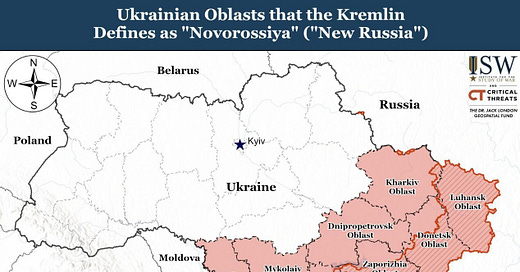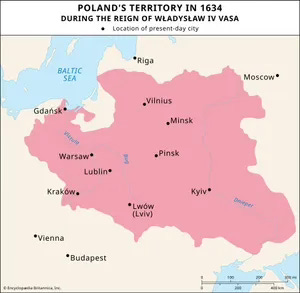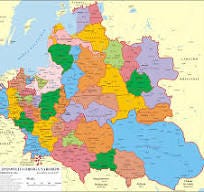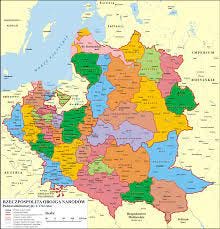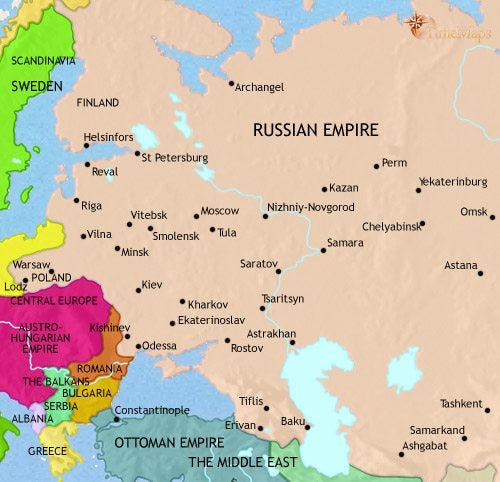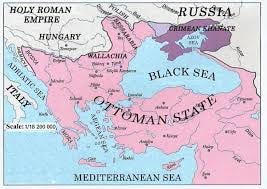Peace Would be a Blessing for Ukraine
Peace Would be a Blessing for Ukraine
By Willem Post
The Ukraine Armed Forces, including the nationalist Azov Battalions (folks with many NAZI tattoos) bombed the eastern Ukraine Oblasts from 2014 to 2022, causing many thousands of deaths and severely wounded.
The ethnic-Russian people, who had lived there for hundreds of years, objected to the US/EU/UK-instigated/financed Coup d’Etat in Kiev in 2014, which caused about 100 dead and seriously wounded.
Those people did not want to be ruled by the NAZI-idolizing, nationalist clique installed by the US/EU/UK, after the Coup.
.
Oligarch Plundering and Minsk Agreements
After 1991, Ukraine’s oligarchs invested nothing in eastern Ukraine for decades, but plundered its wealth as much as possible, so after the Coup in 2014, those ethnic Russian people resisted the Ukraine regime:
1) To gain the autonomy to end the plundering, and
2) To end Kiev’s “Erase Everything Russian Program”, which forced them to give up their Russian culture, language, religion, Russian language media, such as TV, radio, books, etc. That program was in violation of the Minsk I and Minsk II Agreements, EU and UN laws.
During the “Wild West/free-for-all” after 1991, Ukraine oligarchs somehow acquire “ownership” of anything worthwhile in Ukraine. For example, Poroshenko, a former President after the 2014 Coup, aka, the Chocolate King with factories in Russia, claimed he owned a shipyard in Crimea, but did not have a paper trail of the transaction. Accordingly, Russia confiscated it after annexing Crimea in 2014.
After 8 years of UAF bombing of East Ukraine, causing many thousands killed and seriously wounded on both sides, Russia gave the ethnic-Russian people a chance to vote, four Oblasts voted to rejoin Russia by over 90% in 2022, as did Crimea by over 96% in 2014.
Minsk Agreements
Merkel and Hollande purposely failed as guarantors of the Minsk Agreements, by 1) ignoring the ethnic-cleansing in East Ukraine and 2) slow-walking the implementation of the Minsk Agreements, to give Ukraine time to train, arm and build fortifications with US/EU/UK providing instructors, weapons and ammo.
Prior to 2022, Poroshenko and Zelensky had officially announced they were not going to implement the Minsk Agreements.
.
Creating the USSR, the Ukrainian SSR and Ukraine Independence
When the Czarist Russian Empire collapsed in 1917, Ukraine nationalists declared independence in 1918, and proclaimed the Ukrainian People’s Republic.
However, this republic was short-lived, because the Reds (Bolsheviks) consolidated control of the territory of the former Russian Empire.
In 1922, they set up a government structure with 15 Soviet Socialist Republics, SSRs, called Union of Socialist Soviet Republics, USSR, and the USSR Central Committee, with Lenin as the Chairman.
.
The USSR Central Committee had sovereignty over all 15 SSRs. It could determine/alter SSR borders, as needed, deal with foreign governments, have embassies and consulates.
The “Ukrainian SSR” (which was not a sovereign, independent country) was created by putting together various Russian lands, which, by 1991, had been sovereign parts of Russia for at least 1991 – 1783 = 206 years.
1) In the east, Novorossiya (excluded Crimea until 1954), which provided access to the Black Sea
2) In the center, the former Zaporizhian Cossack Hetmanate, stretching from beyond Kiev in the west to beyond Kharkiv in the east. See below image.
3) In the west, land areas ceded by Poland, Slovakia and Rumania, by treaty to the USSR from 1939 to 1948.
Ukraine remained within the USSR until 1991, when it declared independence again, a move ratified in a referendum and widely recognized by the international community.
.
Special Military Operation and Novorossiya
For more than 25 years, NATO expanded beyond East Germany, after promising Gorbachev in 1991 NATO would not expand “one inch beyond East Germany”. Russia objected each time such expansions took place.
.
The 2014 Coup d’Etat in Kiev, that installed a nationalist regime, with Banderite, AZOV battalions sporting NAZI symbols, was the last straw. Those same battalions were used to “teach east Ukrainians (those Russians) a lesson” from 2014 to 2022, 8 years. These battalions used Azovstal Iron and Steel Works in Mariupol to make a last stand. Eventually about 2500 surrendered to Russian forces. See URL and Note.
https://www.nytimes.com/2022/07/24/world/europe/ukraine-war-mariupol-azovstal.html
.
NOTE: Stepan Bandera, revered by Ukraine as a nationalist hero, but criticized by others as a NAZI collaborator/mass murderer of Poles, Jews, etc., during WWII.
He was a leader of the Organization of Ukrainian Nationalists (OUN-B), a radical wing of the OUN.
He fought for Ukrainian independence during World War II. See URL
.
Putin had put forward a strategic plan in December 2021, that asked for Ukraine not to join NATO in exchange Ukraine being closely tied to the EU. It was summarily ignored.
In February 2022, UAF had amassed over 100,000 troops on the line of separation, and had increased its rate of firing munitions 3 to 4 times.
In response, Russia launched its Special Military Operation. Immediately, Russia was named “the invaders, the breakers of international laws, etc.”
The foghorn of the government-owned/subsidized Corporate Media was in full Russo-phobia mode.
.
Istanbul I Peace Conference, April 2022
.
Putin withdrew his troops from Kiev and other places, as part of the terms of the “initialed” April 2022 Istanbul Peace Accord.
However, Ukraine reneged on the accords, likely at the insistence of the US/EU/UK (PM Johnson paid a visit to Kiev), who wanted to keep fighting to “strategically weaken Russia”, as part of a long-term US/UK “break-up-Russia project” dating back to at least 1917
.
Istanbul II Peace Conference, May 2022
Trump wants to end the killing so he can concentrate on and devote more resources to MAGA.
Russia wants that as well.
After the first session, which lasted less than 2 hours, Russia, on the following Monday, made clear, it is sticking by initial demands raised by Moscow during Istanbul I Peace Conference, April 2022. BTW, both sides spoke Russian so nothing was lost in translation.
.
Russia will not give up Crimea, and the annexed regions of Donetsk, Luhansk, Zaporizhzhia, and Kherson Oblasts.
Russia's control and sovereignty over these territories is non-negotiable.
Russia wants international recognition of Crimea, Sevastopol, the DPR, the LPR, the Kherson and Zaporozhye regions as part of Russia.
All the commitments Kiev assumes must be legally binding, contain enforcement mechanisms and be permanent
Russia proceeds from the premise, Kiev’s non-accession to NATO, as well as reaffirming its neutral and non-aligned status, as per the 1990 Declaration on Ukraine’s State Sovereignty.
.
Russia wants the erasure of the legacy of the neo-Nazi regime that usurped power in Kiev after the US/EU/UK-instigated, violent, Coup d'Etat, in February 2014, including the initiative by its perpetrators to eradicate and cancel, in both physical and legislative terms, everything Russian, be it the Russian language, media, culture, traditions, or the canonical Orthodox faith
Russia wants Ukraine to enact legislation to restore and protect Russian language, culture, and churches and monasteries in Ukraine.
About one-third of the country has spoken Russian as its first language for hundreds of years, and many more know it as a second language.
Ukraine nationalists have been waging a state persecution campaign against the largest Church in Ukraine, at times outright seizing monasteries and churches, and arresting bishops and priests, because it has not broken spiritual communion with the Moscow Patriarchate,
Russian language media, such as TV, radio, books, etc., have been banned.
.
Here is a summary:
1) No Ukraine membership in NATO,
2) No NATO “peacekeepers” in Ukraine,
3) No nationalist-inspired “Erase-Everything-Russian Program”,
4) Demilitarizing and de-Nazifying of Ukraine,
5) Normal state-to-state relations with Ukraine,
6) Lifting of sanctions and withdrawing of lawsuits and cancelling of arrest warrants
7) Returning Russian assets subjected to the so-called freeze in the West.
8) Russia will pay to rebuild all Russian lands, Ukraine and western partners will pay to rebuild all remaining Ukraine lands.
.
In typical demagogue fashion, Zelinsky said: “Ukraine will not give up any territory to the invaders. These are Ukraine lands. They belong to the people”.
He and his cohorts surely know, but do not want to mention:
.
1) All lands around the Black Sea were part of the Ottoman Empire for hundreds of years. See below image,
2) After a few wars, the Ottoman Empire ceded the Tartar Crimean Khanate to Russia in 1783,
3) The USSR Central Committee, led by Lenin, created the “Ukrainian SSR” (which was not a sovereign, independent country), in 1922, by putting together various Russian lands, which in 1991, had been sovereign parts of Russia for at least 1991 – 1783 = 206 years.
.
Unconditional Cease Fire Demanded by the Coalition of the Willing
Trump said: “Russia is winning. If Ukraine fights another three years, it will lose the entire country”.
That is the main reason the “Coalition of the Willing” and Ukraine, with the US as a “backstop”, are desperate to force Russia, under threat of more sanctions, into an unconditional, air/sea/land, 30-day cease fire.
This arrogant demand of the losers amounts to we stop the fighting, insert de facto NATO troops as “peacekeepers”, and then we will see what we will talk about.
The West would use that period to provide equipment, “instructors/mercenaries”, and ammo, while Ukraine would regroup, rearm, dig trenches, etc.
Russia ignored the demand, because the cease fire did not mention 1) the root causes of the conflict, and 2) that Russian interests and requirements would be discussed.
See URLs
.
Coalition of the Willing has Weak Underpinnings
Ukraine oligarchs have been stealing about 30% of financial aid/weapons/ammo from the US/EU/UK, from 2014 to the present.
They sold their loot on the international weapons market, a major additional windfall to their normal plundering.
They do not want US/EU/UK gravy train to stop. If the US pulls out, that gravy train will be at least 50% smaller.
If an EU “Coalition of the Willing” decides to “continue the fight”, it would mean the near-zero, real-growth GDP of the already-troubled EU/UK would carry 1) the full Ukraine fighting load, and 2) the Ukraine oligarch-stealing would be only from the EU/UK. After a few more years of fighting, the EU/UK aims to:
.
1) Sell more goods and services to the Ukraine market
2) Have low-cost access to Ukraine mineral resources; oil, gas, rare earths, etc.
3) Have low-cost access to Ukraine fertile lands; “breadbasket of Europe”,
4) Have low-cost strategic access to the Black Sea and Caspian Sea oil and gas,
5) Turn Crimea into: a) a major NATO base, b) cruise ship destination, c) a retirement/tourist Mecca, a la Monaco
That “continue-the-fight” route would require the European-wide Russo-phobia to be in full swing to brainwash the people to sacrifice their standard of living to be ready pay and die to fight evil Russia, the invaders.
The EU trade surplus with the US is a major gravy train for the EU, which likely will be much smaller in the future.
No wonder, more and more EU people, with stagnant/decreasing real wages, are revolting against militarism, censorship and election interference emanating from Brussels..
.
Comments on Image
Novorossiya refers to territories gained by Russia starting in 1667, over 350 years ago.
The below contemporary image of Novorossiya shows small parts of the Kherson and Zaporizhia Oblasts, on the west bank of the Dnieper, and of the Donetsk Oblasts, are not yet recovered by Russia.
The Entire Ukraine Area was a Part of the Czarist Russian Empire
Almost all people do not know, Ukraine is an artificial political entity put together with various Russian lands:
1) In the east, Novorossiya (excluded Crimea until 1954), which provided access to the Black Sea
2) In the center, the former Zaporizhian Cossack Hetmanate, ZCH, stretching from beyond Kiev in the west to beyond Kharkiv in the east.
3) In the west, land areas ceded by Poland, Slovakia, Hungary and Rumania, by treaty to the USSR from 1939 to 1948.
The image shows the ZCH (light green area), in 1654, against the backdrop of contemporary Ukraine.
Some area of the ZCH was in contemporary Belarus.
.
.
Polish-Lithuanian Commonwealth, PLC
At the Union of Lublin, Poland and Lithuanian became one state and established the PLC in 1569.
Poland was the dominant partner.
Lithuania had gained control of Kiev and surrounding lands in 1362.
The entire area was transferred to the PLC, as part of the Union of Lublin in 1569
Treaty of Pereyaslav (1654). The Orthodox-Christian ZCH asked to become a protectorate of the Orthodox-Christian Czar of Russia, as codified in the Pereyaslav Treaty of January 1654.
This marked a big turning point in favor of Russia, and much to the disadvantage of PLC and Poland.
Poland did not want the ZCH to become a protectorate of Russia.
The result was the Russia-Poland war, 1654 to 1667, 13 years, with Russia occupying the entire ZCH
Treaty of Hadiach (1658). During that war, the ZCH provisionally became part of the PLC, but this union was short-lived and never fully implemented. The treaty aimed to make the ZCH an autonomous part of the Commonwealth, like a troika, but it faced resistance by the eastern Cossack people, who preferred to continue being a protectorate of the Czar of Russia. The treaty was ultimately rejected.
The treaty envisioned a ZCH with its own military, courts, and treasury, alongside a Ruthenian/Lithuanian nobility, which would require the ZCH people to pay taxes for support of the nobility.
Treaty of Andrusovo (1667). As part of peace negotiations, the ZCH was divided.
The Right-Bank (excluding Kiev and surrounding land) was given back by Russia to the PLC
The Left Bank (plus Kiev and surrounding land) remaining a protectorate of Russia
Treaty of Perpetual Peace (1686). The definitive legal settlement was spelled out in the treaty, concluded by Russia and Poland. The treaty re-affirmed Russia's sovereignty over the ZCH on left bank of the Dnieper, including the city of Kiev, on the right bank of the Dnieper.
In 1764, Catherine II of Russia annexed the eastern area of the ZCH. It was incorporated as Little Russia Governorate, headed by Pyotr Rumyantsev, in 1764
In 1775, Catherine II of Russia, as part of the partitions of Poland, annexed the western area of the ZCH, thus eliminating the semi-autonomous ZCH within the shrinking PLC. See image.
Partitions of Poland
After Russia annexed eastern area of the ZCH, the PLC experienced a significant loss of land and people
These losses ultimately led to the three partitions of the PLC (1772, 1793, and 1795), which resulted in the complete loss of Polish and Lithuanian sovereignty in 1795
Poland, as a sovereign state, ceased to exist for 123 years, from 1795 to 1918.
.
The below image is labelled “Polish Territory in 1634”, stretching to near Moscow.
It should be labelled PLC, because its outline shows the ZCH is part of the PLC, whereas the ZCH provisionally joined the PLC in 1658. This is an example of “map/document invention” to serve political purposes.
.
.
The below mage shows PLC before annexation of eastern part of ZCH by Russia (large blue area)
.
The below image shows PLC after annexation of eastern part of the ZCH by Russia, plus Russia annexed other areas in the east and north.
Only a small area of the ZCH remained with Poland/PLC (small blue area in the south)
.
Novorossiya aka New Russia
Below image shows the extent of the Russian Empire and Novorossiya in 1800; it bordered on the Habsburg Empire
Catherine the Great moved the border of Russia westward and southward, just as the US moved its border westward and southward, adding territories which included Crimea, Belarus and Lithuania.
Agreements with Prussia and Austria led to three partitions of Poland, in 1772, 1793, and 1795, extending Russia's borders well into central Europe. See images.
She was born Sophie Friederike Auguste von Anhalt-Zerbst, a principality in Stettin, Germany, on May 2, 1729, ruled Russia from July 9, 1762, after overthrowing her husband Czar Peter III, until her death on November 6, 1796.
She officially annexed the eastern area of the ZCH in 1764. It was incorporated as Little Russia Governorate, headed by Pyotr Rumyantsev, in 1764.
This area was part of Russia from 1764 to 1991, or 227 years
She annexed the western area of the ZCH, on the right bank of the Dnieper, in 1775, thus eliminating semi-independent rule of the western Cossacks.
This area was part of Russia from 1775 to 1991, or 216 years. See above images
She annexed the Crimean Tatar Khanate from the Ottoman Empire, OE, in 1783.
This area was part of Russia from 1783 to 1991, or 208 years
She founded Odessa in 1794 on the site of the Ottoman Empire, OE, fortress town Khadzhibei.
She annexed most of the eastern parts of the PLC during the three partitions of Poland.
These partition areas were part of Russia starting from 1775 to 1991, 216 years.
Poland, as a sovereign state, ceased to exist for 123 years, from 1795 to 1918
,
Sweden
Finland (Livonia) was part of Sweden for almost 700 years, starting around 1150.
The Russia waged a war against the Kingdom of Sweden from 21 February 1808 to 17 September 1809, to protect the Russian capital, Saint Petersburg, founded by Czar Peter the Great in 1703.
Russia defeated Sweden which ceded Finland to Russia on September 17, 1809
Russia converted Finland into an autonomous part of the Russian Empire, named Grand Duchy of Finland.
Finland declared independence on 6 December 1917, which was recognized by Lenin’s government on December 31, 1917.
.
.
In 1914, the entire Ukraine area, including Kiev, Odesa, Kharkov, etc., plus the eastern half of Poland (annexed in 1795), Finland annexed in 1809), Estonia, Latvia, Lithuania, etc., were integral parts of the western Russia.
The Kingdom of Prussia annexed the western half of Poland in 1795 (yellow)
Poland ceased to exist as sovereign states from 1795 to 1918, 123 years.
The red part is the Austro-Hungarian Empire, which collapsed in 1918 to become two separate states, Austria and Hungary.
The 1914 map shows Finland, Ukraine, Estonia, Latvia, Lithuania, and the Caucasus as part of Russia.
.
.
The Ottoman Empire
In 1600, the OE included almost all borderlands of the Black Sea.
The Crimean Tartar Khanate, CTK, was a vassal state of the OE.
The CTK controlled the Black Sea border lands from present-day Moldova to past Rostov, and bordered in the north to Russia. See below image
.
For hundreds of years, Tartars rounded up ZCH and Russian peasants, and sold them as slaves to the OE.
The local Russians/Cossacks appealed to Russia for relief.
After several Russian-OE wars lost by the OE, most of the Black Sea borderlands became part of Russia in 1783, except for 1) Rumania, 2) Bulgaria, and 3) present-day Turkey.
The Ottoman Empire, by treaty, ceded the CTK to Russia in 1783, more than 240 years ago, which put an end to the slave raiding business.
Odessa was founded by the Katherine the Great in 1794 on the site of the OE fortress town of Khadzhibei.
.
Annexing the CTK ultimately gave Russia access to the Black Sea, a continuous arc from the Caucasus to Rumania.
https://www.kyivpost.com/post/7118.
The image shows the CTK
.
.
Russia in the 1900s
The CRE dissolved in 1917
The entire Ukraine area was part of the CRE
A Civil War pitched the Whites (Czarists) against the Reds (Socialists)
The Reds won, despite a 20,000 expeditionary force, mainly from the UK and US, to support the Whites
.
The Russian Soviet Federative Socialist Republic, RSFSR, was founded as a socialist state, from 1917 to 1922
The RSFSR was replaced by the USSR, consisting of 15 SSRs, in 1922
The Central Committee of the USSR had sovereign control over all SSRs, including interactions with foreign countries.
It determined the boundaries of each SSRs, including the “Ukraine SSR”, as needed.
The entire Ukraine area was incorporated as part of the RSFSR in 1919 with Kharkiv as its capital.
The Ukraine area was re-named “Ukraine SSR” in 1922, with Kharkiv remaining as its capital until 1934
Kiev was the capital of the Ukraine SSR from 1934 to 1991
.
Russian Lands to Central and Eastern Ukraine SSR
The Central Committee of the USSR established the borders of the Ukraine SSR in 1922
It transferred lands (formerly the Crimean Tartar Khanate) to give the Ukraine SSR access to the Black Sea
It placed the Azov Sea area under joint control with the Ukraine SSR
It added Crimea to the Ukraine SSR in 1954, as part of the 300-y celebration of the Pereyaslav Treaty of January 1654.
.
Russian Lands to Western Ukraine SSR
Western Ukraine is mostly made up of lands ceded by various countries to the USSR:
1) Poland ceded Eastern Galicia and Volhynia to the USSR by treaty in 1939
The USSR added those lands to the Ukraine SSR in 1939
2) Czechoslovak ceded Transcarpathia to the USSR by treaty in 1945.
The USSR added it as Zakarpattia Oblast to the Ukraine SSR in 1946
3) Rumania ceded Bessarabia and northern Bukovina to the USSR.
The USSR added them to the Ukraine SSR in 1940 and 1948
.
The USSR lasted from 1922 to December 26, 1991
The Ukraine SSR declared independence on August 24, 1991, which was affirmed by a referendum on December 1, 1991, where 90% of voters supported independence.
Ukraine finally became an independent, sovereign country at the end of 1991
NOTE:
The 90% was likely due to Ukrainians thinking Russia would be similar to the USSR, which turned out not to be the case, especially after Putin became President on 7 May, 2000, after the disastrous/chaotic rule of Yeltsin, who resigned, and told Putin to “save Russia”, which he did by 1) liberalizing Russia, 2) creating a strong defense of Russia, 3) limiting Western activities in Russia, 5) aligning with China and India, and 6) creating BRICS, a growing alliance of like-minded nations.
.
If a Presidential election were held in Ukraine in the near future, the EU likely would have many voting stations in West Europe, etc., to enable Ukrainians to vote, but allow only a few stations in Russia, as was done during the recent Moldova Presidential election, to ensure the current President would “win”.
.
Russian Demands for Peace in Ukraine are Draconian, but the Alternative for Kiev is Capitulation
By Paul Serran
On Substack and X
.
Putin is winning the war, and his conditions fully reflect that fact.
The Corporate Media is filled with ‘leaks’ regarding the Russian demands for peace in Ukraine.
The Kremlin has responded by saying, the negotiations are being held behind closed doors, and therefore the Russian will not comment, but for once we can be pretty sure the list being circulated is legit.
.
Unlike the ever-changing Ukrainian conditions and red lines, Vladimir Putin’s Russians have been very consistent in their demands since the beginning of the war, with one exception: the territorial demands.
.
During the 2022 negotiations in Istanbul, Russia demanded the totality of the Donetsk and Luhansk regions,
During the 2025 negotiations in Istanbul, Russia also demanded the Zaporozhian and Kherson regions.
.
It’s been reported, when the Istanbul talks were halted after less than 2 hours, the Russian delegation warned that ‘next time’ the number of Ukrainian regions returned to Russia’s ancestral lands can increase from 4 to 6 or 8.
.
1) Ukraine must adopt a neutral status without the presence of foreign troops and no weapons of mass destruction on its territory.
2) Kiev must renounce its demands for reparations from Moscow.
3) Ukraine must come to terms with the loss of Crimea and four other regions.
4) Putin will agree to a ceasefire only after Ukraine withdraws its troops from these regions.
5) The Kremlin wants all five regions to be recognized as Russian at the international level.
.
Thus, the peace proposal is:
1) No NATO membership
2) Neutral status
3) Restoration of rights of the Russian population
4) Restoration of the church
5) No possibility for the west to use Ukraine as a proxy again!
6) Taken territories in Ukraine become Russian”
.
While this is a more informal formulation, it does include the respect for the Russian-speaking populations, a fundamental reason for the war, and a real-life problem in Ukraine that also affects the Hungarian minority.
.
The restoration of the banned Ukrainian Orthodox Church – for alleged Russian ties – is another real issue.
.
Russian troops on the move: for Kiev, alternative to peace is to risk capitulation
The territorial concessions are an almost insurmountable problem, as Russia demands Kiev withdraw from small portions of the four regions it has not yet conquered.
Just to illustrate how dramatic that is, this would include, for example, Zaporozhian City – with 700+ thousand inhabitants.
The only reason for Zelensky and his regime to even entertain these draconian conditions is that, if they do not, they risk a much worse settlement later on, or even total capitulation.
.
Ukrainian, a War-Mongering Proxy of the West
Zelensky was told to reject Minsk 1 and 2 (a real good deal for Ukraine)
Zelensky was told to reject already-signed Istanbul 1 in 2022 (also a real good deal for Ukraine)
.
Ukraine and especially the West (for face-saving reasons), desperately need a ceasefire, because the Ukraine armed forces face total destruction in a few months.
At present, it is losing about 1400 killed and seriously wounded each day, and Russia is returning more and more Ukrainian regions to Russia’s ancestral lands.
.
The West does not give a damn about the killing of the Slav Russians and Slav Ukrainians, otherwise it would have stopped Kiev’s 8-y genocide of ethnic Russians in East Ukraine from 2014 to 2022.
After a few more years of fighting, the US/EU might eventually:
.
1) Sell goods and services to the Ukraine market
2) Have low-cost access to Ukraine mineral resources; oil, gas, rare earths, etc.
3) Have low-cost access to Ukraine fertile lands; breadbasket of Europe,
4) Have low-cost strategic access to the Black Sea and Caspian Sea oil and gas,
5) Turn Crimea into: a) a major NATO base, b) cruise ship destination, c) a retirement/tourist Mecca, a la Monaco.
.
The EU/US had been aiming to weaken Russia and take over its resources, as it almost succeeded from 1991 to 2000. Those resources, and Northern Sea Passage, are at least 25 times more valuable than Ukraine’s.
As a consolation prize, the EU/US is desperately trying to get as much “value” out of Ukraine as possible to recover its “investments”.

